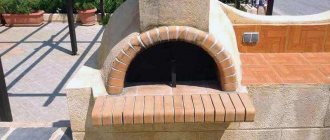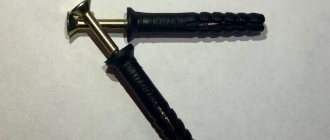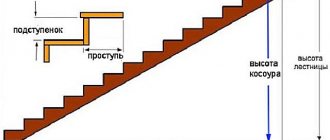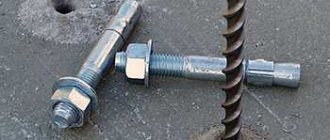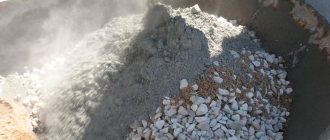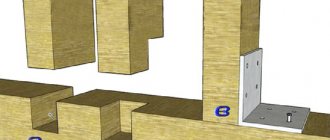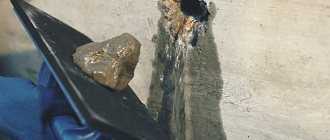How to fix a wooden pole to concrete - 4 installation methods
In private construction, it is often necessary to attach wooden poles to a concrete base. The natural material, which has a fragility, is widely used as an element of a fence, foundation, extensions to the main estate or outbuilding. Therefore, there are several ways to combine two substances with completely different properties - wood and concrete.
Installation methods
To install structures with wooden elements, you need to choose the right type of wood. Since installation will be carried out in an environment with moisture, soft rocks will quickly collapse. It is better to make wooden posts for a fence or foundation from oak or beech; they are strong and solid. It takes a long time for them to decompose. The disadvantage of this material is its very high cost. Therefore, you should choose a product from a different cost segment. A good option is stepsons made of pine or larch. They have sufficient density, rot easily, do not attract insects, and when moisture escapes, the logs do not crack or deform.
Before installing a wooden column in a monolithic structure, additional protective treatment of the material of natural origin should be performed, since it is destroyed over time from aggressive environmental influences. The above-ground part of the pillar must be treated with a varnish solution, which will weaken the effects of sunlight, precipitation, and weathering. The underground foundation also needs to be protected from the destructive effects of moisture and microorganisms. Bitumen impregnations are most suitable as a protective solution. The treatment is carried out in two steps with a 24-hour interval between jobs.
Before applying the protective coating, the wooden base should first be dried and sanded. To treat a dry and smooth surface, much less impregnation mixture will be used.
Pouring concrete mortar
The method of installing a wooden column is suitable in regions with a dry climate and with soil unsaturated with moisture. The main work is preceded by the preparatory stage of preparing the site for installation and digging holes for supports. If the soil is dry, to make digging easier, the well sites are moistened with water. The depth of the pit depends on the height of the fence element - for a 150 cm post they dig 50 cm, for longer steps - 80 cm. The underground part of the log should correspond to 30% of its total length.
If in the area under construction the level of soil water is high, then to prevent the destruction of the tree, a hole is dug to a depth exceeding the freezing limit of the soil. A crushed stone layer with a thickness of 150-200 mm is laid at the bottom of the well; it will serve as a drainage system and remove excess moisture. The lower part of the wooden stepson is wrapped with a roll of hydrophobic agent, treated with open fire or impregnated with a bitumen mixture.
Next, install a wooden support in the hole, fill it with mixed soil, crushed stone, and broken bricks. This installation is carefully compacted into the well. A distance of 150-200 mm is left to the ground level; prepared concrete will be poured into this “nest”. After the monolithic solution has matured, the joint between it and the wooden post is additionally treated with a hydrophobic substance. This installation will provide the structure with strength and comparative durability.
Reinforcement
This method involves installing a wooden pole on a concreted area. Before pouring the solution, reinforcement rods are pre-installed at the installation site of the stepsons, which should rise 200-250 mm above the surface of the base. Next, a hole is made in the lower part of the support, which should correspond to the diameter of the reinforcement. To create a waterproofing layer, a water barrier substrate is installed between concrete and wood.
This method is used when mounting the upper and lower trim to the supports, which combines the columns into a single whole. The method is popular in the construction of garden, country gazebos and other structures on a strip foundation.
Installation features
You can secure a wooden pole to concrete using a special device - a stepson made of a monolith. This structure is mounted on a column filled with mortar - a stepson, to which a wooden support is secured with wire. Work begins by covering the wooden product and excavating it in the ground with a hydrophobic substance in the form of impregnation from bitumen or film material. The bottom of the pit is covered with crushed stone, and a stepson is installed in the hole. It is supported by spacers for a secure fit. Then the hole is filled with soil, crushed stone, broken bricks, and this mass is compacted using improvised means. When 150-200 mm remains to the ground surface, backfilling is stopped and concrete is poured into the hole. After the monolith has matured, the wooden support is tied with wire to the stepson.
What kind of foundation is needed?
If the porch is planned to be light - wooden or metal - the foundation is most often made of piles or columns. Specifically chosen based on geological conditions. On well-draining soils with low groundwater levels, it is sufficient; if there is a tendency to heave, it may be necessary.
For a heavy porch - made of brick or monolithic concrete - a strip foundation is made or. The type of foundation is most often similar to the one on which the house is built.
Next, you need to decide whether you will connect the porch foundation to the house foundation or not. Decisions are made based on the planned mass of the extension and the type of soil. Both options have disadvantages. If there is no connection, cracks often form at the junction of the porch and the house; due to frost heaving, the porch may become warped. Owners of dacha plots often face this problem - usually the porch to the dachas is made of wood and is disconnected. After the ground thaws, it may “sit” in place on its own, or it may require some additional measures.
When installing connections, it is also possible for cracks to form, but not only at the joint, but also in the “body” of the extension. This happens if the reinforced connections installed cannot compensate for the uneven load created by the house and the extension. Therefore, a connected foundation for a porch is made if it is attached to a heavy house and is itself heavy and massive, made of reinforced concrete. The second difficulty with this decision is to make the connection high-quality. To do this, use ribbed reinforcement with a diameter of 12-16 mm, for which holes are drilled in the foundation with a given diameter. Reinforcement is hammered into them and a frame for the porch is knitted on its basis.
There are two main designs of stairs: on bowstrings and on stringers. They can be made of wood or metal. There are also combined options - metal + wooden steps or metal + concrete steps.
Staircase designs - on bowstrings and on stringers
On the bowstrings
Stairs on bowstrings are the simplest. For a porch - a good option, especially if the house is wooden or a small country house. Support bars are attached to the inside of the bowstring. If you are working with metal, the bars are welded horizontally (with a minimum slope of 1-2° to allow water to drain from the steps). In the case of wood, support bars can either be nailed to which the step will then be attached, or recesses can be cut into the bowstring (no more than 1/2 the thickness of the board), into which the step boards are inserted.
On the stringers
A staircase on stringers can also be of a simple design - with open supports. In this case, triangles are cut at the required angle in the upper part of the board. Their lower part serves as a support for the steps.
When cutting the stringer, set aside the height of the step and the width of the tread. They are connected at right angles. Using the applied markings, a template is made, with which all steps are marked.
The number of stringers in a staircase depends on its width and the thickness of the boards used for the steps. The thinner the board for the steps, the more often you need to install stringers. If you use 25 mm boards, then there should be a distance of no more than 50-60 cm between the two supports. If you need a larger staircase width and don’t want to install three stringers, use thicker boards. It is important that they do not bend under your feet.
If you decide to weld a ladder on stringers from metal, you will need to be patient: you will have to weld many small sections, but the formation principle is the same.
Methods of fastening parts
The lower edge of the porch stairs can sometimes rest directly on the ground. This option is simple, but unreliable. Firstly, the soil may settle and the stairs will begin to collapse. Secondly, upon contact with the ground, both wood and metal are destroyed faster. There are special impregnations for wood (Senezh and Senezh Ultra, for example), and metal is well prepared with a primer and painted in several layers. However, it is better to make a base - pour a shallow tape on which the bowstrings or stringers will rest.
There are two ways to attach a porch ladder to a reinforced concrete base - to a beam - a beam with a cross-section of at least 75 * 75 mm or to an embedded beam of a smaller cross-section (pictured on the left).
Difficulties may also arise with the installation of porch posts. There are several ways. There is one very simple and effective one that works great even on heaving soils (clays and loams). Holes 50-60 cm deep are dug under the pillars. A bucket and a half of sand is poured into them at the bottom and compacted well. Half a bucket of crushed stone is poured on top of the sand and compacted too. They put up a pole, level it, put spacers that will hold it in a given position. The space between the wall of the hole and the pillar is gradually filled with crushed stone, tamping it thoroughly. The hole is filled flush with the ground, the top can be concreted (so that precipitation does not drain), but not spilled to the very bottom. Pillars installed in this way do not lead even with severe heaving. A significant part of the water goes into the sand, and the remaining forces of frost heaving are absorbed by the rubble, neutralizing them.
If piles, a strip foundation or a monolithic slab are poured under the pillars of the porch, or a columnar base is laid, then studs or special glasses are walled into the concrete to secure the wooden posts. After the concrete has matured, the rack bars are attached to them with wood grouse or bolts.
If the racks are metal, a corner with a wall thickness of at least 3-4 mm is placed in the concrete so that it can be easily welded to it later.
When building a wooden porch with your own hands, questions may arise about attaching the railings and balusters. They can be assembled using ordinary nails, but if desired, you can use bolts or wood grouse. In this case, holes are pre-drilled, then fasteners are installed in them and tightened using an angle wrench. Such a connection is certainly more reliable than simply using nails.
If the porch is attached to a freshly cut wooden house, in which the shrinkage has not yet been completed, and the design of the porch provides for a canopy, the posts must be attached to special adjustable plates.
Please note that both the metal and wood that you will use to build the porch require careful processing. The porch is exposed to all climatic influences and the materials require good protection.
Monolithic concrete stairs
The most durable stairs are made of monolithic concrete. They take longer to manufacture than metal or wood ones, but their service life is calculated in decades. The types of concrete stairs are described in detail in the video. The basics of calculation are also given.
How to make a concrete staircase on stringers with your own hands, see the following video.
Wooden porch
A wooden porch is one of the most common options in our country. Wood is plastic, easy to process, costs relatively little (in our country), and forgives many mistakes. That is why it is a favorite building material.
It also has disadvantages: it requires good protection before construction begins (antibacterial impregnations and fire retardants), as well as regular maintenance - updating the protective paint coating. Then it looks attractive for a long time, otherwise it quickly loses its decorative effect.
One of the options for building a wooden porch with a ladder on bowstrings can be seen in the video. Please note that the porch is being built on sandy soil, so the method used to install the pillars is not suitable for everyone. Everything else is clear.
Brick porch
Since brick is a dense and heavy material, a brick porch requires a serious foundation. Usually this is a monolithic slab, with double reinforcement and it is better if it is larger in size than the planned porch.
When calculating the parameters of the steps, it is necessary to take into account the dimensions of the brick and the thickness of the seam between them. Then the laying work will be easier - no need to cut the brick. If you are not going to cover the porch, use high-quality material for the outer rows. The inner rows - backfilling - can be made from scrap or building blocks and their remains.
Brick porch with wooden steps
If the house is on a high base, making a monolithic brick porch is too expensive. Then the columns or walls are folded, leaving empty space inside. It can then be used for household purposes or covered with decorative panels. If an upper platform is needed, these columns/walls are covered from above with a concrete slab - homemade or ready-made - this is your choice. Then a staircase is attached to the resulting base. It doesn't have to be brick. It can be metal, concrete or a combination.
How to fix a wooden pole on concrete: concreting the pole and mounting it on the base
In the process of performing various construction works, sometimes it becomes necessary to attach a wooden pole to concrete. As a rule, this operation raises many questions among novice masters. In this article we will look at how to attach wooden poles to a concrete base in several ways.
Wooden pole mounted on concrete
General information
The need to install wooden poles on concrete can arise in a variety of situations, for example, when installing fences, building gazebos and other wooden structures on a strip foundation.
At first glance, it may seem that installing a wooden pole on concrete is very difficult, but in reality, professionals have some tricks that allow them to cope with this operation without any difficulties. Below you can see for yourself.
general information
At first glance, the situation is complicated, but there are tricks that help you cope with the work without much difficulty. Before you begin installation, you should choose what kind of wood the future base will be made of and carefully process it. Wood processing is an important process, because when exposed to the environment, it deteriorates.
Processing is carried out on the prepared post. The support is divided into two halves, each of them is treated with a different chemical. The part that is underground is more susceptible to moisture; it is treated with bitumen-based solutions twice, maintaining an interval of a day. The second part of the post is usually coated with varnish, protecting the wood from wind, sun and moisture.
Important! Before processing, the wood must be dried, and careful sanding will help save bitumen impregnation.
Installing a wooden post on concrete
First of all, it should be said that installing pillars on concrete often means different operations:
| Type of transaction | Peculiarities |
| Concreting | The post is installed in a hole that is filled with concrete |
| Fixing on a concrete base | The pillar is fixed on a flat concrete surface using special devices. |
Below we will take a closer look at each of them.
Pillar concreting
Many novice home craftsmen doubt whether it is possible to concrete wooden poles, since wood in concrete can quickly rot. In fact, if you follow a certain technology, the wooden support can stand for quite a long time.
Instructions for performing this operation look like this:
- The first step is to make a hole to the depth of soil freezing. In different areas, this depth may be different, but on average in our country it is 1.2 m. If you make the hole shallower, then there is a possibility of the pillar being pushed out as a result of soil heaving. The easiest way to dig a hole is with a garden drill, but if you don’t have one, you can use a regular shovel.
- Next, you need to fill the bottom of the hole with crushed stone or gravel, and compact it well. The layer thickness should be about 15 cm.
Treatment of timber with impregnation
- Before concreting a wooden post, it is necessary to treat the wood with a protective compound. Currently, specialized stores sell special impregnations that protect wood from moisture penetration, exposure to microorganisms and other negative factors.
- After processing, the post must be installed in the hole and secured with spacers. In this case, its position should be checked with a building level to prevent deviation from the horizontal.
- Next, the space in the hole is filled with concrete.
- Protruding concrete must be smoothed down with a slope away from the post so that water does not accumulate near the wood.
- The concrete must then be covered with damp burlap. It must be moistened periodically throughout the week. This procedure prevents concrete from cracking during the drying process.
In the photo - treating the joint with sealant
- After the concrete has completely hardened, you need to treat the area where it meets the wood with sealant. This will prevent moisture from entering the joint space, which will form during the freezing/thawing process.
Advice! The durability of a wooden structure largely depends on the type of wood. For example, pine and larch have good moisture resistance. Moreover, the price of pine is the lowest among other species.
This completes the process of concreting the pillar. It should be noted that there is another way to install a wooden pole in the ground. Its meaning lies in the fact that a small column (concrete stepson) is concreted, to which a wooden beam or log is attached on the surface using wire tying.
Photo report: wooden porch on a metal frame
A theory is just a theory, and in construction too. You always understand the essence of the matter better if you observe the process yourself, because you can see how others do it and learn something for yourself.
At the request of the parents, an exact copy of the old porch was made. The only difference is that the new one has a welded metal frame.
In place of the demolished porch, a pit with a depth of 25 cm was dug. Sand was poured and compacted into layers at the bottom, crushed stone was placed on it - 10 cm each. A metal mesh with a mesh of 10 cm was laid on top and the whole thing was filled with concrete.
A metal frame was welded according to the previous dimensions of the porch (from a 70*5 mm corner). The sidewalls are set vertically and secured with studs. Next, the base for the benches is welded to them. All metal is treated with a rust converter, primed and painted twice.
The wood used for construction was dry. Planed boards were cut to size (the width of the porch) and treated with impregnation for direct contact with the ground.
We lay the dried boards on the frame. You have to drill a hole for each fastener - you can’t just take a corner.
At this stage, two mistakes were made at once. The first is that the sheathing did not start from the sides. They immediately began laying the steps. As a result, water constantly flows into the joints of the side paneling and steps and warps the wood. It is necessary to start the cladding from the sides, and make the steps a little longer so that they protrude beyond the side cladding by at least a couple of centimeters. The second mistake is that the boards on the porch are laid close to each other. With high humidity they swell and the surface becomes uneven. When laying porch sheathing, make gaps of at least 5-8 mm.
After all the boards are secured, they are sanded. First, with a belt sander with a coarse grain, then with a disk sander with a fine grain. The process is long. At the same time, the task of removing the green color of the impregnation is being solved. It is not covered even by three layers of tint.
After sanding, we begin painting. We apply it three times. Each layer after the previous one has completely dried. The resulting color is dark mahogany.
While the paint dries completely, we begin making the benches. We cut boards for them, grind down an oblique chamfer (for beauty), and cover them with impregnation.
We make the backs with a small decor - roundings at the edges.
We saw along the marked lines with a jigsaw, then sanded to a smooth edge.
The sides are covered with plywood, which was painted the same color. The porch is ready.
Do-it-yourself finished wooden porch - side view
Fastening a wooden post into concrete
Wooden building material, despite its fragility, is constantly used in buildings. Used as a base for fences, decoration of extensions, as foundation parts. During work, the tree must be periodically attached to the concrete. Many questions immediately arise: how to properly install wooden poles, how to extend their durability? Answers to them require preparation.
Advantages and disadvantages of a fence on wooden posts
Among building materials, wood stands apart and is in a privileged position:
- The use of special mastics and protective impregnations allows you to reveal the beautiful texture of the wood;
- Wooden posts, with the correct choice of cross-section of supports and completed installation, can provide high strength of the fence at relatively low cost;
- Wooden posts can be easily combined with metal, corrugated sheets, wooden slats and any other material for cladding the fence.
Wooden poles, unlike concrete or steel poles, can be easily installed with your own hands, while the light weight and good workability of wood allows you to manufacture and process the poles almost at home.
Important! Wooden posts are extremely sensitive to excess moisture and putrefactive microflora, so the quality of the material processing determines how long the posts will last in the ground.
There are many ways to treat the material, but not all recipes provide a stable and long-lasting effect, so the method of applying a protective coating must be selected in accordance with the composition of the soil and the type of wood.
How to Protect Wooden Fence Posts from Rotting
The durability of a wooden support depends primarily on the type of wood. The wood that is most resistant to rotting is larch, oak, and walnut. Pine, spruce, and fir withstand putrid environments worse. Poplar, birch, and aspen are considered unsuitable for use as poles. Experts recommend that before installing poles, provide protection against the development of putrefactive microflora by the following means:
- Impregnation in two or three doses with antiseptics based on organic solvents;
- Treatment with salts of iron, copper, chromium, nickel, lead, creosote;
- Coated with protective waterproof compounds, for example, epoxy or pentaphthalic varnishes.
Advice! Processing is usually carried out in several stages, with each layer drying. To install wooden posts in the most aggressive peaty soils, the lower part of the support can be wrapped in sealed plastic bags.
All kinds of drying oils, organic oils, impregnation with used machine oil, kerosene, and diesel fuel are considered ineffective for protection.
Installation methods
After completing the preparatory work, we proceed to installation. We mark and prepare the place for the supports. Options for installing poles are determined by the design features and the nature of the work. Installation means concreting a support or fixing it to concrete. There are main methods:
- universal concreting of the base;
- use of concrete stepson;
- installation on concrete;
- use of frame;
- special connection;
- platform with a box.
Return to contents
Versatile method - concreting
Installation of wooden poles using concreting is well suited for soils with low humidity. The installation method involves preliminary preparation of holes for the base, installation of pillars in them and filling the remaining space with concrete.
To increase efficiency when digging holes, the ground is watered; the ground becomes soft and easy to work with. When the height of the pillars is 1.5 m, the depth for the hole is 0.5 m; for higher ones, the depth is increased to 0.8 m. The pillar is deepened by 1/3 of its length.
When the groundwater level is high, the supports are deepened below the soil freezing level and the bottom of the holes is covered with a layer of crushed stone up to 15-20 cm, which acts as drainage. The bottom of the supports is wrapped with roofing felt, fired, and treated with resin to better protect the wood.
Having completed the preparation, they begin to compact the holes. The holes are filled with crushed stone, pieces of brick mixed with soil, and compacted tightly. We leave 15-20 cm to the top of the hole, and the empty space is filled with concrete. After the solution dries, the pole holds tightly and will not bend under the load. The joint between concrete and wood is treated with a sealant, which prevents moisture from getting between them.
DIY brick and concrete porch: photo
The walls of the staircase landing were pre-built from brick, on top of which a monolithic concrete slab was poured. Along the edge, a frame of corners is embedded into it so that the stairs and railings can be welded.
Porch plan: how everything should look
From a corner 70*70*5 mm we cut blanks of the required length. After which we treat them with a rust converter. We start cooking after the reaction has stopped and the metal has dried.
We welded the first metal string.
The finished sidewall was attached to the concrete base with two pins.
Attaching to a concrete support support
We cook the second string in the same way and secure it. When working, make sure that the two bowstrings are in the same plane.
We begin to weld the support bars. Here it is important to constantly monitor the horizontality so that the steps are not oblique.
We weld transverse pieces of the corner to the support bars to form a shelf.
The corners are welded so that they form a frame. We put a piece of slate sheet in it. We lay out a reinforcing metal mesh on the slate. We weld the edges of the mesh to the frame.
We pour concrete into the prepared steps. We make it high-quality so that the steps do not wear out longer.
While the concrete gains strength, we begin to work on the posts that will support the canopy over the porch. For them we take a profiled pipe 70*40*3 mm. We cut four columns from it. Two are slightly longer - they will be near the wall of the house, two are 15 cm shorter - they stand on the outer edge of the porch, creating the necessary slope - so that the water and snow melt off normally. For railings and crossbars we use profiled pipe 40*40 mm.
All metal is also treated with a rust converter.
First we set up the racks, grab them, install temporary stops
To avoid lateral stresses, it is important to position the racks strictly vertically. We set them up, grab them, use short seams in several places, and check again whether they are positioned correctly. We weld the temporary stops and only after the next check we weld them according to all the rules.
Once all the posts are aligned and welded, you can assemble the railings. At the required height they are fixed strictly horizontally.
Then we proceed to install the roof. We also cook it from a 40*40 mm profile pipe. First, strapping around the perimeter - at the level of the shorter posts, then - the rest of the structure. It's not complicated, but it takes a lot of time - a lot of intersections.
Then it was time to do the railings and decorations. And again, there are no difficulties, it can be done easily if desired.
That's it, the porch is ready for finishing work. Rough tiles for outdoor use were purchased for the steps and landing. The sidewall of the monolithic slab was also trimmed with it.
The metal was painted with paint that matched the tone, and the corrugated sheeting left over from the installation of the roof was used on the roof. The DIY porch turned out pretty good.
Concrete stepson
The second way to install a wooden pole is to use a concrete stepson. The essence of the concreting procedure is to use not the entire log, but a small column. The sequence of the procedure is as follows:
- before installation, the support is treated with an antiseptic, the part of the stepson that will be in the ground is covered with bitumen and wrapped with roofing felt;
- crushed stone is poured onto the bottom of the hole;
- vertical fixation of the support with spacers;
- Be sure to fill the wooden post with crushed stone, gravel and compact it well. Maintaining a compaction interval (every 30 cm), adding sand and water will help increase the density of the backfill;
- 15-20 cm to the top, the hole is filled with a concrete solution, which ensures stability.
After the concrete has hardened, it is necessary to secure the log with wire to small posts.
Concrete base
Installation of a wooden support using a concrete base can be easily done in several ways:
- Special mount embedded in concrete. By special fastening we mean a pin with a special fastening in the form of the letter P at its end. The cross-section of the beam must correspond to the dimensions of the fastening so that the tree fits easily into the device. The inserted beam is attached with screws and bolts. The method has its drawback - only timber is used as a wooden support.
- Fittings. In the absence of a specially prepared connection, ordinary reinforcement is used. The inserted iron pin into the concrete should protrude 20-25 cm above the surface. A hole is drilled on the support, the diameter of which corresponds to the diameter of the reinforcement. A seal is applied to the concrete to protect the structure from water penetration. The size of the seal is smaller than the wooden support. The joints between the pillars and concrete are covered with mortar. If necessary, the upper and lower frames will help connect all the pillars into a common structure. This option is more often used on a strip foundation.
- A box with a platform is used for hardened concrete. The wooden material is placed in a specially made box, to which a platform is welded from below. Dowels are screwed into the holes on the platform, with the help of which the box is attached to the concrete.
Step-by-step instructions for attaching joists to concrete with your own hands
Attaching wooden joists to a concrete floor is easy, even on your own. There are several mounting options, and below are the steps of one of the standard methods.
- Lay waterproofing (roofing felt or simple PVC film) on the concrete base. The joints between the pieces must be secured with special tape.
- Next, you need to lay out the logs along the floor in a certain step. This step will depend on the material from which the finishing flooring will be made: when using a 25x100 mm tongue and groove board, the logs can be laid with an indent of 70-80 cm, but for other materials the step will need to be reduced to 40 cm.
- If the length of the material is not enough to cover the entire room, then the elements can be joined using an iron angle or by making cuts that form a connection into a root tenon.
- Before installing the joists on the concrete floor, you need to take care of the outermost joists that will be located near the walls. They must be laid level, clearly leveling their height by placing wooden planks or pieces of plywood under the beams. It is most convenient to use a laser level. When the outermost logs are fixed, a nylon thread is stretched between them, which will serve as a guide when installing the remaining logs.
- To attach timber to a concrete floor, you need to make holes in both. You need to drive a dowel or steel anchor spacer into the hole in the concrete. Each joist must be fixed with at least four anchors, and the screws must be placed 40-60 cm from each other.
- You need to prepare levelers for the joists in advance - cut chipboard or plywood into even strips. With the help of these elements, the joist structure is fixed in a level position (pieces of plywood are simply placed under the joists if you need to raise them) so that the finishing coating on it does not creak or move.
- If, on the contrary, there are bulges in the concrete base, then you will have to level the lag not by placing plywood, but by selecting part of the material from below using a plane.
- When all the logs are installed in their places, thermal insulation should be laid between them, for example, expanded clay.
- Before covering with the topcoat, you should think about laying the necessary communications. It is also advisable to use a vapor barrier layer.



